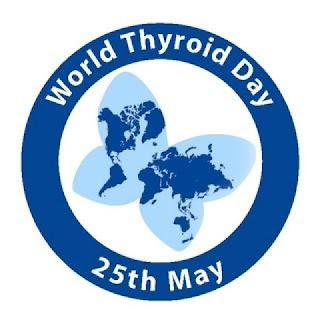 Today is International Thyroid Awareness Day.
Today is International Thyroid Awareness Day.I am celebrating by posting a few thoughts on the current views of Hashimoto's Thyroiditis.
Many people out there will tell you that autoimmune thyroiditis comes from the thyroid gland being attacked by antibodies. People measure those and try to evaluate their degree of thyroid health by them.
My endocrinologist advised me to stop measuring those things. "Once you have them, they're there for life. Genetics plays a big role. At some point, a stress related event may have triggered them and they would exist in your body, once in a while getting to your thyroid, until they destroy it and render it incapable of doing its job". So, according to her, there is no way to go but down and measuring antibodies levels is not constructive or conducive to any worthwhile conclusions. I have to admit, despite my continuing efforts and gluten free diet, the results of my own lab tests indicate she might have a point... Unfortunately...
Dr. Datis Kharazzian, who has a best selling book on Hashimoto's, thinks one can balance the immune system and thus stop the killing of the thyroid. He says Th1 and Th2 cells are out of balance in Hashimoto's and that all the patient has to do is bring them back into the desired equilibrium. He offers combinations of nutrients that would boost either Th1 or Th2.
Dimitry Chistiacov's study, "Immunogenetics of Hashimoto's thyroiditis", published in the "Journal of Autoimmune Diseases" in March, 2005, seems to indicate that it is only the Th1 cells that are to blame for the said destruction. So, if you believe in Dr. Kharazzian's balancing of the immune system you may combine it with the results of this study and go for increasing Th2 right off the bat.
Dr. Alexander Haskell (link to the right) thinks that autoantibodies (Anti-TPO and Anti-TGO) are not the culprits in this scenario. He says they are simply there to clean the thyroid cell debris and that lack of specific nutrients is the culprit for the destruction that does occur at the thyroid gland level. He isolates iodine among those and this has caused some serious rebuttals of his vision (as iodine deficiency is hardly a problem in the US.) If he hadn't emphasize iodine, his theory would have actually sounded a lot more credible - and it is my favorite, still...
Like Dr. Haskell, Ray Peat does not believe in "autoimmune diseases" and the body's feasting on itself via antibodies, like those described above. He thinks that the thyroid does get destroyed (like many other organs) and that this is a process of degeneration, a result of insufficient supply of energy at the cell level. A nutrition blunder, if you will.
His view is consistent with the symptoms I have had after my Paleo time -- and, apparently, more and more people come out of their low carb experiments with damaged thyroid glands.
But let us go back to D. Chistiacov's study mentioned above, from which I have stolen the graphic above (I am giving it back if there are any complaints). His description of how things go wrong in Hashimoto's is representative for the scientific community's viewpoint. Indeed, my own doctor told me about the "strong genetic component" to Hashimoto's, to which environmental triggers are added.
Incorrect nutrition is not considered a factor in this study. However, infection and pregnancy are...
A key phrase in D. Chistiacov's paper remains:
"The mechanisms, whereby autoreactive T cells escape deletion and anergy, and become activated, remain uncertain. "
This leaves the field still open to many interpretations, in my mind, including that of Dr. Peat and Dr. Haskell -- that the said breakdowns of cells are primarily caused by issues other than our own cells gone crazy and that we can stop or even reverse that destruction through a combination of nutrition, lifestyle and supplementation. I will attempt in full Dr. Haskell's protocol (described in his video series) once I have the necessary ingredients and let you know how it goes.




